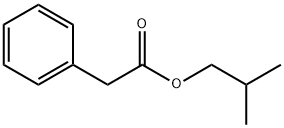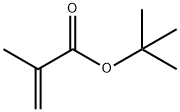Isobutyl acrylate
Synonym(s):Isobutyl 2-propenoate;Isobutyl acrylate
- CAS NO.:106-63-8
- Empirical Formula: C7H12O2
- Molecular Weight: 128.17
- MDL number: MFCD00042865
- EINECS: 203-417-8
- SAFETY DATA SHEET (SDS)
- Update Date: 2024-12-18 14:15:30

What is Isobutyl acrylate?
Chemical properties
Liquid.Contains 100 ppm monomethyl ether hydroquinone as inhibitor.
The Uses of Isobutyl acrylate
Isobutyl Acrylate is used in of acrylic acid metal salt resin with good antifouling performance.
The Uses of Isobutyl acrylate
Monomer for acrylate resins.
What are the applications of Application
Isobutyl acrylate is useful for polymer synthesis
General Description
A clear colorless liquid with an acrid odor. Flash point 86°F. Less dense than water. Vapors irritate eyes and respiratory system. May polymerize exothermically if heated or contaminated. If polymerization takes place inside a container, the container may rupture violently.
Air & Water Reactions
Highly flammable. Slightly soluble in water
Reactivity Profile
Isobutyl acrylate is an ester. Esters react with acids to liberate heat along with alcohols and acids. Strong oxidizing acids may cause a vigorous reaction that is sufficiently exothermic to ignite the reaction products. Heat is also generated by the interaction of esters with caustic solutions. Flammable hydrogen is generated by mixing esters with alkali metals and hydrides. Polymerizes readily in the presence of heat and light generating much heat; reacts with strong oxidants. REF [Handling Chemicals Safely, 1980. p. 235].
Hazard
Flammable, moderate fire risk.
Health Hazard
Moderate toxicity when swallowed. Contact with the eyes causes minor irritation no worse than that caused by hand soap.
Fire Hazard
HIGHLY FLAMMABLE: Will be easily ignited by heat, sparks or flames. Vapors may form explosive mixtures with air. Vapors may travel to source of ignition and flash back. Most vapors are heavier than air. They will spread along ground and collect in low or confined areas (sewers, basements, tanks). Vapor explosion hazard indoors, outdoors or in sewers. May polymerize explosively when heated or involved in a fire. Runoff to sewer may create fire or explosion hazard. Containers may explode when heated. Many liquids are lighter than water.
Flammability and Explosibility
Flammable
Chemical Reactivity
Reactivity with Water No reaction; Reactivity with Common Materials: No reactions; Stability During Transport: Stable; Neutralizing Agents for Acids and Caustics: Not pertinent; Polymerization: Polymerizes upon exposure to heat; uncontrolled bulk polymerization can be explosive; Inhibitor of Polymerization: Methyl ether of hydroquinone: 10 - 100 ppm; Hydroquinone: 5 ppm.
Properties of Isobutyl acrylate
| Melting point: | -60°C |
| Boiling point: | 132 °C (lit.) |
| Density | 0.89 g/mL at 25 °C (lit.) |
| vapor pressure | 8.13hPa at 22.9℃ |
| refractive index | n |
| Flash point: | 91 °F |
| solubility | soluble in Ether,Alcohol |
| form | clear liquid |
| color | Colorless to Almost colorless |
| Odor | Sharp, fragrant. |
| Odor Threshold | 0.0009ppm |
| Water Solubility | 7.903g/L(temperature not stated) |
| BRN | 1749388 |
| Stability: | Stability Heat and light sensitive. Susceptible to polymerisation. Flammable. Incompatible with strong oxidizing agents, aldehydes. |
| CAS DataBase Reference | 106-63-8(CAS DataBase Reference) |
| NIST Chemistry Reference | 2-Propenoic acid, 2-methylpropyl ester(106-63-8) |
| EPA Substance Registry System | Isobutyl acrylate (106-63-8) |
Safety information for Isobutyl acrylate
| Signal word | Warning |
| Pictogram(s) |
 Flame Flammables GHS02  Exclamation Mark Irritant GHS07 |
| GHS Hazard Statements |
H226:Flammable liquids H315:Skin corrosion/irritation H317:Sensitisation, Skin H335:Specific target organ toxicity, single exposure;Respiratory tract irritation H412:Hazardous to the aquatic environment, long-term hazard |
| Precautionary Statement Codes |
P210:Keep away from heat/sparks/open flames/hot surfaces. — No smoking. P233:Keep container tightly closed. P273:Avoid release to the environment. P280:Wear protective gloves/protective clothing/eye protection/face protection. P303+P361+P353:IF ON SKIN (or hair): Remove/Take off Immediately all contaminated clothing. Rinse SKIN with water/shower. |
Computed Descriptors for Isobutyl acrylate
New Products
Tert-butyl bis(2-chloroethyl)carbamate (S)-3-Aminobutanenitrile hydrochloride N-Boc-D-alaninol N-BOC-D/L-ALANINOL N-octanoyl benzotriazole 4-Hydrazinobenzoic acid 3,4-Dibenzyloxybenzaldehyde 1,1’-CARBONYLDIIMIDAZOLE R-2-BENZYLOXY PROPIONIC ACID 1,1’-CARBONYLDI (1,2-4 TRIAZOLE) 4-HYDROXY BENZYL ALCOHOL 3-NITRO-2-METHYL ANILINE (2-Hydroxyphenyl)acetonitrile 4-Bromopyrazole 5-BROMO-2CYANO PYRIDINE 5,6-Dimethoxyindanone 5-broMo-2-chloro-N-cyclopentylpyriMidin-4-aMine 4-methoxy-3,5-dinitropyridine 2-(Cyanocyclohexyl)acetic acid 2-aminopropyl benzoate hydrochloride 1-(4-(aminomethyl)benzyl)urea hydrochloride tert-butyl 4- (ureidomethyl)benzylcarbamate diethyl 2-(2-((tertbutoxycarbonyl)amino) ethyl)malonate Ethyl-2-chloro((4-methoxyphenyl)hydrazono)acetateRelated products of tetrahydrofuran








You may like
-
 Isobutyl Acrylate (stabilized with MEHQ) CAS 106-63-8View Details
Isobutyl Acrylate (stabilized with MEHQ) CAS 106-63-8View Details
106-63-8 -
 Isobutyl acrylate, stabilized with 100ppm 4-methoxyphenol CAS 106-63-8View Details
Isobutyl acrylate, stabilized with 100ppm 4-methoxyphenol CAS 106-63-8View Details
106-63-8 -
 Isobutyl acrylate CAS 106-63-8View Details
Isobutyl acrylate CAS 106-63-8View Details
106-63-8 -
 55441-95-7 99%View Details
55441-95-7 99%View Details
55441-95-7 -
 N-Vinylformamide 99%View Details
N-Vinylformamide 99%View Details
13162-05-5 -
 Chloro Uracil 1820-81-1 99%View Details
Chloro Uracil 1820-81-1 99%View Details
1820-81-1 -
 2-ethyl-6-methyl-3-hydroxypyridine succinate 99%View Details
2-ethyl-6-methyl-3-hydroxypyridine succinate 99%View Details
127464-43-1 -
 2-ETHYLPYRIDINE 100-71-0 99%View Details
2-ETHYLPYRIDINE 100-71-0 99%View Details
100-71-0